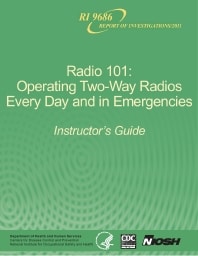Mining Product: Radio 101: Operating Two-Way Radios Every Day and in Emergencies
Original creation date: August 2011
Authors: CY Kingsley Westerman, MJ Brnich, C Kosmoski
NIOSHTIC2 Number: 20039824
Pittsburgh, PA: U.S. Department of Health and Human Services, Public Health Service, Centers for Disease Control and Prevention, National Institute for Occupational Safety and Health, DHHS (NIOSH) Publication No. 2012-103 (RI 9686), August 2011 ; :1-20
Radio 101 is a program to train miners in the use of two-way radio communication in the mines.
This training tool provides detailed information and scripts for use by instructors when conducting training for miners on everyday and emergency radio communication in mining. The training program is intended for use in a group training setting or for individual trainees and includes an Instructor's Guide, a Microsoft PowerPoint® instructional presentation and a Student Handbook.
This instructor's guide is intended for use in a group training setting or for individual trainees and should be used in conjunction with the included PowerPoint presentation, "Radio 101: every day and emergency radio use" (CD-ROM) and the Radio 101: Student Handbook (publication).
With new requirements for communications and tracking systems, as mandated by the MINER Act of 2006, new issues may arise with the use of radios both on a daily basis and in emergencies. For example, if every miner has a handheld radio, there could be a problem with inundation of the airwaves in an emergency, causing a delay in the communication of important information. Also, miners will have more access to handheld radios, so it may be worthwhile to provide all miners with training on how to properly use those radios.
 In the past, the ineffective use of communications systems within mines in emergency situations has caused a variety of problems. During the Sago Mine disaster in West Virginia in January 2006, the improper use of handheld radios resulted in immeasurable pain for the families of the deceased as they were mistakenly informed that there were 12 survivors and 1 dead when, in fact, 12 miners had died and only 1 had survived. This training may be able to prevent a similar situation from occurring in future emergencies. Further, relative to the new systems mines are required to install, miners will need to know how to use both primary and secondary communications systems.
In the past, the ineffective use of communications systems within mines in emergency situations has caused a variety of problems. During the Sago Mine disaster in West Virginia in January 2006, the improper use of handheld radios resulted in immeasurable pain for the families of the deceased as they were mistakenly informed that there were 12 survivors and 1 dead when, in fact, 12 miners had died and only 1 had survived. This training may be able to prevent a similar situation from occurring in future emergencies. Further, relative to the new systems mines are required to install, miners will need to know how to use both primary and secondary communications systems.
Rather than focusing on the technical details and specialized terms of communications systems, the tips provided in this training program will focus on briefer, rule-of-thumb information which can be used to improve the chances of successful communication under less-than-optimal circumstances. New miners may not understand the potential consequences of not answering the phones in an emergency situation. For new miners, these consequences should be stressed in training and include the use of examples. Trainers should explain the meaning and significance of various visual and audible warning systems used in their mine to new miners. They may not understand the significance or consequences of failing to take action in response to these warning systems.
Audience: Mine trainers

NIOSHTIC2 Number: 20039824
Pittsburgh, PA: U.S. Department of Health and Human Services, Public Health Service, Centers for Disease Control and Prevention, National Institute for Occupational Safety and Health, DHHS (NIOSH) Publication No. 2012-103 (RI 9686), August 2011 ; :1-20